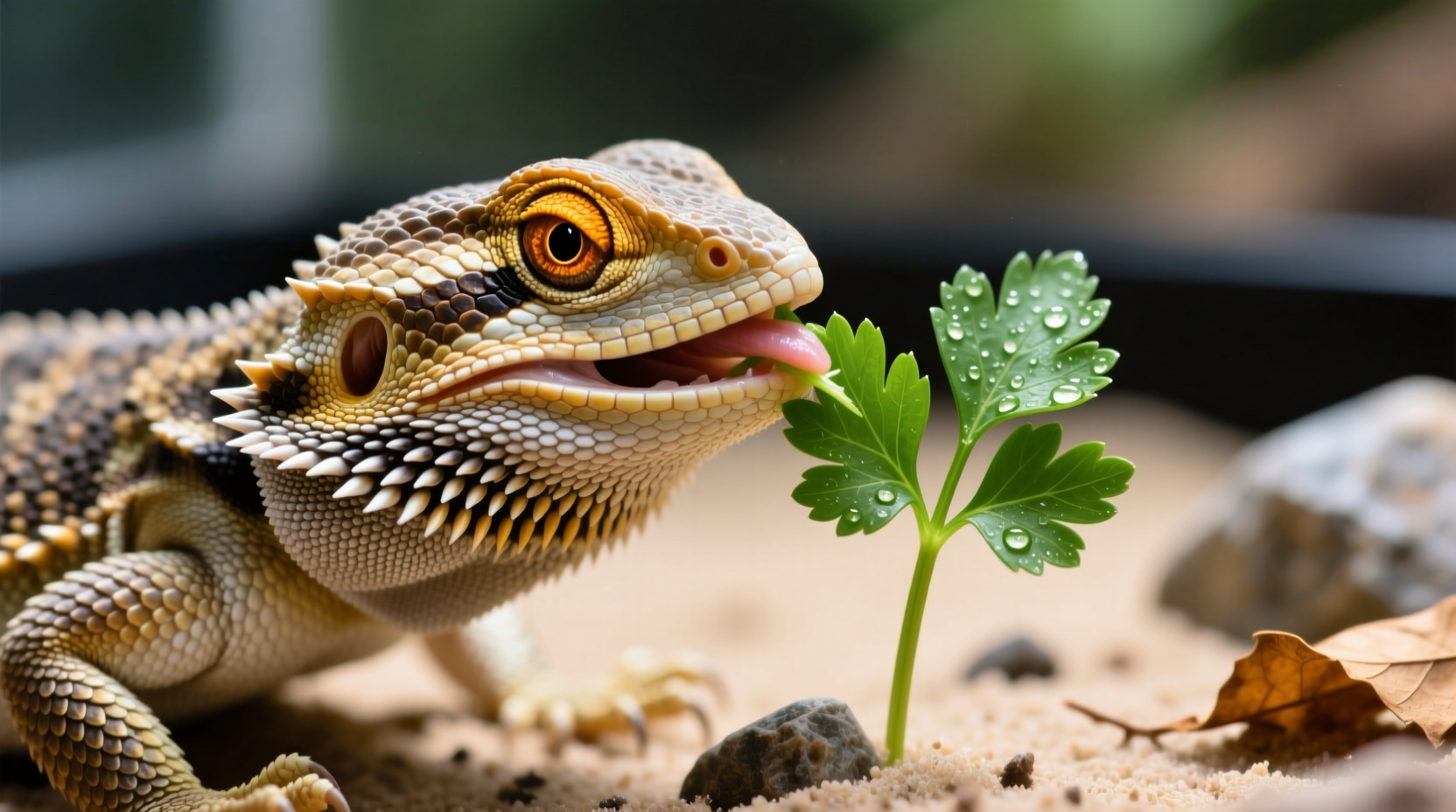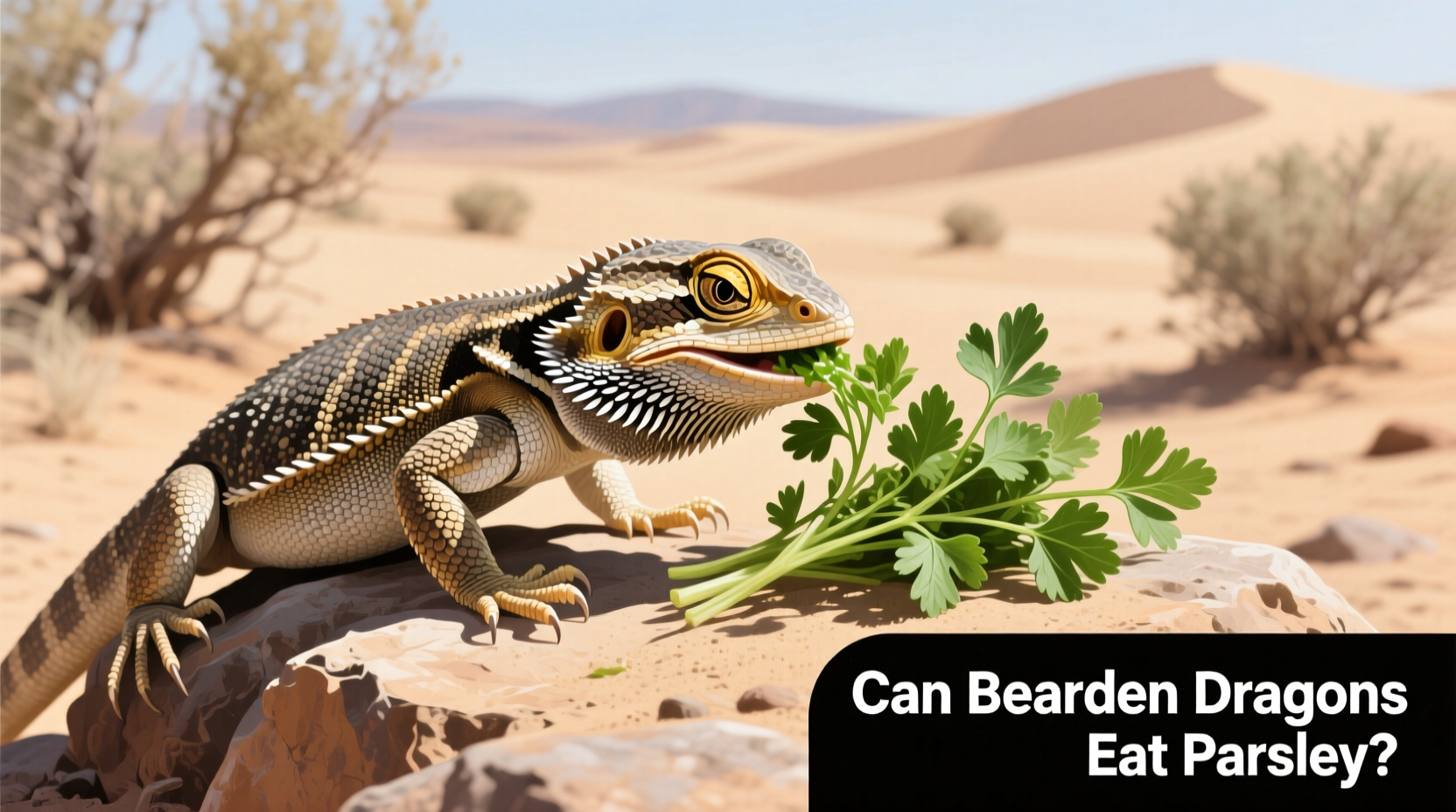Understanding proper nutrition is critical for your bearded dragon's health and longevity. Many new beardie owners mistakenly believe parsley is a healthy staple green, not realizing its potential dangers. This comprehensive guide examines the science behind parsley consumption for bearded dragons, providing clear feeding guidelines backed by veterinary research and nutritional analysis.
Nutritional Profile of Parsley for Bearded Dragons
Parsley contains valuable nutrients like vitamin A, vitamin C, and calcium—but its nutritional benefits come with significant caveats. The critical factor determining whether parsley helps or harms your pet is the calcium-to-oxalate ratio.
| Nutrient | Amount per 100g | Impact on Bearded Dragons |
|---|---|---|
| Calcium | 138mg | Essential for bone health, but effectiveness reduced by oxalates |
| Phosphorus | 58mg | Ideal calcium:phosphorus ratio should be 1.5-2:1 (parsley is 2.4:1) |
| Oxalates | 1,700mg | Binds calcium, preventing absorption and potentially causing deficiencies |
| Vitamin A | 421μg | Beneficial in proper amounts, but excess causes toxicity |
This nutritional analysis comes from USDA FoodData Central (2023) and aligns with reptile nutrition research published by the Association of Reptilian and Amphibian Veterinarians. The high oxalate content fundamentally changes how your bearded dragon processes the calcium present in parsley.
Why Oxalates Pose a Serious Risk
Oxalates bind with calcium to form calcium oxalate crystals that your bearded dragon cannot absorb. Over time, this binding effect depletes available calcium stores, potentially leading to metabolic bone disease (MBD)—a painful, debilitating condition affecting 60-90% of improperly fed captive reptiles according to veterinary studies.
Dr. Susan Brown, a leading exotic animal veterinarian with over 25 years of reptile nutrition experience, explains: "The calcium in high-oxalate foods like parsley becomes essentially unavailable to bearded dragons. What looks like a calcium-rich food on paper becomes counterproductive in practice."

Safe Feeding Guidelines for Parsley
If you choose to offer parsley, follow these science-based recommendations:
- Frequency: Maximum once per month (not weekly or bi-weekly)
- Portion size: No larger than the space between your dragon's eyes (approximately 1-2 small leaves)
- Preparation: Thoroughly washed, chopped into bite-sized pieces
- Timing: Offer only on days when you've provided calcium supplementation
- Monitoring: Watch for changes in appetite or bowel movements after feeding
Better Vegetable Alternatives to Parsley
Several greens provide superior nutritional profiles without parsley's risks. These vegetables maintain proper calcium bioavailability while delivering essential nutrients:
- Collard greens: Calcium:oxalate ratio of 6.5:1 (excellent bioavailability)
- Dandelion greens: Naturally high in calcium with minimal oxalates
- Mustard greens: Good calcium content with lower oxalate levels
- Endive: Balanced nutrition with moderate calcium absorption
- Squash varieties: Nutrient-dense with virtually no oxalates
According to research from the University of California, Davis School of Veterinary Medicine, rotating these low-oxalate vegetables creates a nutritionally complete diet that supports optimal bearded dragon health without the risks associated with high-oxalate foods like parsley.
When to Avoid Parsley Completely
Certain situations warrant complete avoidance of parsley in your bearded dragon's diet:
- Young dragons under 18 months (critical bone development phase)
- Dragons with existing metabolic bone disease symptoms
- During breeding season when calcium demands increase
- When feeding insects with poor calcium:phosphorus ratios
- If your dragon shows any signs of digestive upset
Veterinary researchers at the Royal Veterinary College note that juvenile bearded dragons have significantly higher calcium requirements than adults, making high-oxalate foods particularly dangerous during their rapid growth phase.
Creating a Balanced Weekly Meal Plan
Instead of focusing on whether bearded dragons can eat parsley, shift your attention to creating a nutritionally balanced weekly diet. This sample meal plan demonstrates proper variety and proportions:
- Monday: 70% insects (crickets, dubia roaches), 30% leafy greens (collards, endive)
- Tuesday: 80% insects, 20% squash and bell peppers
- Wednesday: 50% insects, 50% mixed vegetables (including occasional pea-sized parsley)
- Thursday: 75% insects, 25% dandelion and mustard greens
- Friday: 60% insects, 40% varied vegetables (kale, zucchini, occasional herbs)
- Saturday: 100% insects (fasting day for digestive rest)
- Sunday: 50% insects, 50% vegetable mix (including calcium-rich options)
This rotational approach prevents nutritional deficiencies while minimizing exposure to potentially problematic compounds like oxalates. Remember to dust insects with calcium powder 3-4 times weekly and provide UVB lighting for proper calcium metabolism.
Recognizing Metabolic Bone Disease Symptoms
Understanding the warning signs of calcium deficiency could save your bearded dragon's life. Watch for these progressive symptoms:
- Early stage: Lethargy, decreased appetite, subtle jaw softening
- Moderate stage: Tremors, difficulty walking, swollen limbs
- Advanced stage: Fractures, severe deformities, paralysis
If you notice any symptoms, consult an exotic veterinarian immediately. The Association of Reptilian and Amphibian Veterinarians emphasizes that early intervention significantly improves recovery outcomes for metabolic bone disease.
Practical Tips for New Bearded Dragon Owners
Transitioning to proper nutrition can feel overwhelming. These practical steps help you avoid common mistakes:
- Start with a digital food scale to measure portions accurately
- Create a feeding chart tracking what and when you feed
- Freeze pre-portioned vegetable mixes for convenient feeding
- Join reptile nutrition forums moderated by veterinary professionals
- Schedule annual check-ups with an exotic animal specialist
Remember that dietary changes should happen gradually over 2-3 weeks to prevent digestive upset. Your bearded dragon's health depends on consistent, science-based nutrition—not trends or anecdotal advice from social media.











 浙公网安备
33010002000092号
浙公网安备
33010002000092号 浙B2-20120091-4
浙B2-20120091-4